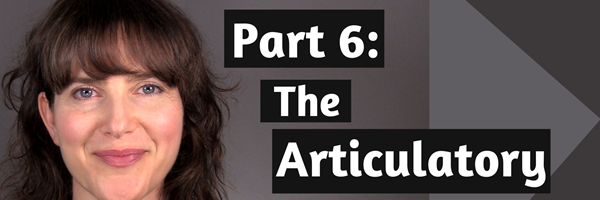(Video Transcript)
American English Voice Placement
American English placement. Have you heard of that term before - placement? It means the place in your body where your voice resonates from - the center of your voice. That might sound vague, but I promise you, placement is a real thing. When I work with accent clients, sometimes their pronunciation is good - they have the correct lip placement, tongue placement, and jaw placement - but still, something sounds different, and that’s almost always the placement of their voice.
American English placement is low - it’s down here, in the upper chest. Not up here in the face or nose. And for some of you, your native language might have a higher placement than American English, so when you speak American English, the overall quality of your voice sounds different than an American’s, even if your lips, jaw, and tongue are in the correct position.
Even different varieties of English have different placements. When I hear people speak English who are from the UK, South Africa, and New Zealand, it sounds like they have a higher placement than American English, maybe somewhere up in the face or nose. American English is low, open, and relaxed.
Before I discuss how to achieve an American English placement, I want to go over a few terms and some basic throat and mouth anatomy so you can have a better understanding of what’s going on inside of your body when you work on placement.
Voice Anatomy and Physiology
This is a drawing of the inside of the nose, mouth, and throat. I’ll point out a few landmarks. This is the tongue, this is the jaw, the teeth, and the lips. This dark area here is the inside of the mouth. This dark area on the top is the nasal cavity, or the inside of the nose. And this dark area here is the inside of the throat. The inside of the throat has a special name; it’s called the pharynx, but you can just refer to it as the throat.
This dark area here is the vocal cords, and the vocal cords are located inside of the throat, just behind the Adam’s apple. If you keep following this tube downward, it leads to the lungs, which you can’t see in this picture.
When you speak, the air travels up from the lungs and goes between the vocal cords and causes them to vibrate. This is where the sound of your voice comes from. Say AHHH, and put your hand on your throat. You will feel a vibration - that’s coming from your vocal cords.
The vocal cords are responsible for giving you the pitch of your voice - is it a high pitch, a low pitch, or a pitch that goes up and down. You can also think of the pitch of your voice as a musical note on a piano. This pitch is higher than this pitch, or this note is higher than this note.
The reason why the inside of the throat, mouth, and nose is shaded a darker color is because these areas are open spaces. Look in a mirror and open your mouth. You’ll see a big open space, except for the space that is taken up by the tongue, teeth, and the roof of the mouth. Everything else is open. That’s why this is called the oral cavity - oral meaning mouth, and cavity meaning an open space. You also have a nasal cavity - the open space inside your nose, and the pharynx, which is the open space inside your throat.
Now, let’s go back to the mouth to show another example. Look in a mirror and open your mouth wide. Now close your mouth to make it small. You just changed the shape of your mouth - you made it big and open, and then you made it small. How did you do that? Well, you used the muscles of the mouth to pull the mouth open or to contract the mouth smaller.
Just like the mouth is surrounded by muscles, so is the inside of the nose and the inside of the throat. So think of these open spaces as being surrounded by thin layers of muscles. You can make the spaces larger by relaxing the muscles and opening them up. Or you can make the spaces smaller by tensing the muscles and making them contract. And notice, too, how the spaces here are all connected. The nose connects to the mouth, and those connect to the throat. It’s one big open space. We call this open space the vocal tract or the vocal system.
Ok, I hope that illustration helped you to understand how it looks on the inside of your mouth and throat, because now we’re going to get to the good part.
How do you control the placement of your voice?
The placement of the voice is controlled by the muscles that surround the nose, mouth, and throat. A voice that has a high placement, something like this, AAA, means that the muscles are tensed, and the entire system is smaller and lifted. And a voice that has a lower placement, something like this, AAA, means that the muscles are relaxed, and the entire system is open and lower. That’s the American placement - a low, open, relaxed sound, which means the entire vocal system is also low and relaxed - the mouth and throat are open.
So you want to relax the muscles inside the mouth and throat so those open cavities can become larger, and allow the voice box, this area here that houses the vocal cords, to relax and be low. This will help to give your voice a nice, full, rich resonant quality.
Voice placement demonstration
I’m going to demonstrate how to change the placement of your voice. I’ll use the vowel, AHH, but you can use any vowel you want. My voice will stay on the same pitch, so I’m not just using a high pitch and a low pitch - I’m going to stay on the same pitch, but the quality of my voice will change. And to make sure I stay on the same pitch, I’m going to use this pitch app called Pitched Tuner, and it’s going to show the pitch of my voice so you’ll be able to see if I”m changing the pitch up or down.
So here’s my normal pitch and normal placement: AHHH. Ok, so my pitch is A3. I'm going to stay on that pitch, or close to it, but you’ll notice how the quality of my voice will change. OK, here goes: AAHH, AHAH, AHH, AHHH. Here’s a nasal placement, AHHH, a forward mouth placement, AHHH, a back mouth placement, AHHH, and a throat or upper chest placement, AHHH. Could you hear the difference in the quality? To do that, I was tensing muscles in my tongue, mouth, and throat - muscles that you can’t see - but I changed the shape of my entire vocal system, and that is what changed the placement of my voice.
American voice placement exercises
Now, let’s move on to the placement exercises.
Here are a few exercises to help you achieve a low, relaxed, open American placement. First, you can do some general relaxation exercises to relax your face, jaw, tongue, shoulders, and upper body. Maybe take a few deep breaths, roll your shoulders up and back a few times, and allow your jaw to open and hang loose.
Now, imagine that your voice is coming from here. Of course, the vocal cords are higher in the throat, and that is where the sound source of the voice actually comes from, but you need to visualize and imagine that the voice is coming from here - your mouth is right here. Use the vowel, Uhh, to bring your voice down and relax. Uhh. Uhhh. Now glide your voice down on a scale as you hum - a nice, relaxing hum. Hmmm. Hmmm. There’s no tension - it’s not - Hmmmmm, it’s hmmmmm. Nice and relaxed. Put your hand on your upper chest and feel your voice resonating here as you glide down. Hmmmm.
Now say a word, like, Hey, and feel your voice resonate in your upper chest as your voice glides down. Hey.
Now start to play around with your voice - play around with the placement - so you can feel what it’s like to have a higher, nasal placement, Hey, hey, with the tongue high in the mouth and the upper muscles of the throat and mouth tensed. Or a front mouth placement, hey, hey, with the tongue placed forward in the mouth and the lips pulled back - or a back of mouth placement, hey hey, with the tongue pulled back into the mouth, and the mouth and throat are opened - and now a lower throat or chest placement, hey, hey - with the tongue lower, and the jaw and throat relaxed.
I hope this video helped you to understand the concept of voice placement, and how to achieve a low, open, and relaxed American placement in your voice.
Thanks so much for watching! And I'd love to hear from you - contact me to learn how we can work together to perfect your American English pronunciation!



